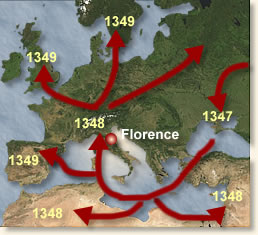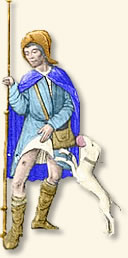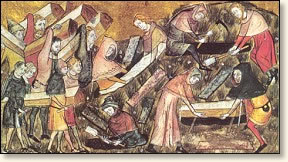|
The Black Death, 1348
Coming out of the East, the Black Death reached the shores of Italy in the spring of 1348 unleashing a rampage of death across Europe unprecedented in recorded history. By the time the epidemic played itself out three years later, anywhere between 25% and 50% of Europe's population had fallen victim to the pestilence.
The plague presented itself in three interrelated forms. The bubonic variant (the most common) derives its name from the swellings or buboes that appeared on a victim's neck, armpits or groin. These tumors could range in size from that of an egg to that of an apple. Although some survived

|
The Plague's Progress
|
the painful ordeal, the manifestation of these lesions usually signaled the victim had a life expectancy of up to a week. Infected fleas that attached themselves to rats and then to humans spread this bubonic type of the plague. A second variation - pneumonic plague - attacked the respiratory system and was spread by merely breathing the exhaled air of a victim. It was much more virulent than its bubonic cousin - life expectancy was measured in one or two days. Finally, the septicemic version of the disease attacked the blood system.
Having no defense and no understanding of the cause of the pestilence, the men, women and children caught in its onslaught were bewildered, panicked, and finally devastated.
The Italian writer Giovanni Boccaccio lived through the plague as it ravaged the city of Florence in 1348. The experience inspired him to write The Decameron, a story of seven men and three women who escape the disease by fleeing to a villa outside the city. In his introduction to the fictional portion of his book, Boccaccio gives a graphic description of the effects of the epidemic on his city.
"The symptoms were not the same as in the East, where a gush of blood from the nose was the plain sign of inevitable death; but it began both in men and women with certain swellings in the groin or under the armpit. They grew to the size of a small apple or an egg, more or less, and were vulgarly called tumours. In a short space of time these tumours spread from the two parts named all over the body. Soon after this the symptoms changed and black or purple spots appeared on the arms or thighs or any other part of the body, sometimes a few large ones, sometimes many little ones. These spots were a certain sign of death, just as the original tumour had been and still remained.
No doctor's advice, no medicine could overcome or alleviate this disease, An enormous number of ignorant men and women set up as doctors in addition to those who were trained. Either the disease was such that no treatment was possible or the doctors were so ignorant that they did not know what caused it, and consequently could not administer the proper remedy. In any case very few recovered; most people died within about three days of the appearance of the tumours described above, most of them without any fever or other symptoms.
The violence of this disease was such that the sick communicated it to the healthy who came near them, just as a fire catches anything dry or oily near it. And it even went further. To speak to or go near the sick brought infection and a common death to the living; and moreover, to touch the clothes or anything else the sick had touched or worn gave the disease to the person touching. "
"...Such fear and fanciful notions took possession of the living that almost all of them adopted the same cruel policy, which was entirely to avoid the sick and everything belonging to them. By so doing, each one thought he would secure his own safety.
Some thought that moderate living and the avoidance of all superfluity would
preserve them from the epidemic. They formed small communities, living entirely
separate from everybody else. They shut themselves up in houses where there
were no sick, eating the finest food and drinking the best wine very temperately,
avoiding all excess, allowing no news or discussion of death and sickness,
and passing the time in music and suchlike pleasures. Others thought just the
opposite. They thought the sure cure for the plague was to drink and be merry,
to go about singing and amusing themselves, satisfying every appetite they
could, laughing and jesting at what happened. They put their words into practice,
spent day and night going from tavern to tavern, drinking immoderately, or
went into other people's houses, doing only those things which pleased them.
This they could easily do because everyone felt doomed and had abandoned his
 |
A plague victim reveals
the telltale buboe on
his leg. From a
14th century illumination
|
property, so that most houses became common property and any stranger who went
in made use of them as if he had owned them. And with all this bestial behaviour,
they avoided the sick as much as possible.
In this suffering and misery of our city, the authority of human and divine laws almost disappeared, for, like other men, the ministers and the executors of the laws were all dead or sick or shut up with their families, so that no duties were carried out. Every man was therefore able to do as he pleased.
Many others adopted a course of life midway between the two just described. They
did not restrict their victuals so much as the former, nor allow themselves
to be drunken and dissolute like the latter, but satisfied their appetites
moderately. They did not shut themselves up, but went about, carrying flowers
or scented herbs or perfumes in their hands, in the belief that it was an excellent
thing to comfort the brain with such odours; for the whole air was infected
with the smell of dead bodies, of sick persons and medicines.
Others again held a still more cruel opinion, which they thought would keep them safe. They said that the only medicine against the plague-stricken was to go right away from them. Men and women, convinced of this and caring about nothing but themselves, abandoned their own city, their own houses, their dwellings, their relatives, their property, and went abroad or at least to the country round Florence, as if God's wrath in punishing men's wickedness with this plague would not follow them but strike only those who remained within the walls of the city, or as if they thought nobody in the city would remain alive and that its last hour had come."
"Brother
abandoned
brother"
|
"One citizen avoided another, hardly any neighbour troubled about others, relatives never or hardly ever visited each other. Moreover, such terror was struck into the hearts of men and women by this calamity, that brother abandoned brother, and the uncle his nephew, and the sister her brother, and very often the wife her husband. What is even worse and nearly incredible is that fathers and mothers refused to see and tend their children, as if they had not been theirs.
Thus, a multitude of sick men and women were left without any care, except from the charity of friends (but these were few), or the greed, of servants, though not many of these could be had even for high wages, Moreover, most of them were coarse-minded men and women, who did little more than bring the sick what they asked for or watch over them when they were dying. And very often these servants lost their lives and their earnings. Since the sick were thus abandoned by neighbours, relatives and friends, while servants were scarce, a habit sprang up which had never been heard of before. Beautiful and noble women, when they fell sick, did not scruple to take a young or old man-servant, whoever he might be, and with no sort of shame, expose every part of their bodies to these men as if they had been women, for they were compelled by the necessity of their sickness to do so. This, perhaps, was a cause of looser morals in those women who survived."
"The plight of the lower and most of the middle classes was even more pitiful
to behold. Most of them remained in their houses, either through poverty or in
hopes of safety, and fell sick by thousands. Since they received no care and
attention, almost all of them died. Many ended their lives in the streets both
at night and during the day; and many others who died in their houses were only
known to be dead because the neighbours smelled their decaying bodies. Dead bodies
filled every corner. Most of them were treated in the same manner by the survivors,
who were more
 |
Citizens of Tournai bury plague victims. These are
fortunate to have coffins. Most victims
were interred in mass graves
|
concerned to get rid of their rotting bodies than moved by charity
towards the dead. With the aid of porters, if they could get them, they carried
the bodies out of the houses and laid them at the door; where every morning quantities
of the dead might be seen. They then were laid on biers or, as these were often
lacking, on tables.
Such was the multitude of corpses brought to the churches every day and almost every hour that there was not enough consecrated ground to give them burial, especially since they wanted to bury each person in the family grave, according to the old custom. Although the cemeteries were full they were forced to dig huge trenches, where they buried the bodies by hundreds. Here they stowed them away like bales in the hold of a ship and covered them with a little earth, until the whole trench was full."
References:
Boccaccio, Giovanni, The Decameron vol. I (translated by Richard Aldington illustrated by Jean de Bosschere) (1930); Gottfried, Robert, The Black Death (1983).
How To Cite This Article:
"The Black Death, 1348," EyeWitness to History, www.eyewitnesstohistory.com (2001).
|






